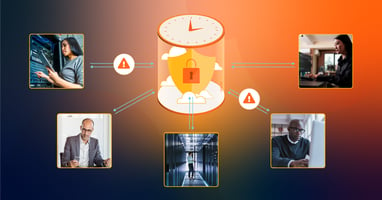The technology hurdles small and medium-sized businesses (SMBs) face are often familiar. Probably the most common of them all is that most companies don’t focus enough on technology challenges that could impact business processes, security, and overall productivity.
Every year, IT departments across the country must tackle new and old challenges alike. For example, they must manage IT resources and budgets, infrastructure, downtime, and cybersecurity.
Some basic steps can avert a potential blue screen of death, but they won’t be able to solve all common IT issues. However, IT departments can solve most technical problems with robust strategies and (sometimes) simple solutions.
Before businesses streamline their IT processes and continue their digital transformation journey, they have to first solve common IT problems.
Top 5 Common IT Issues and How to Solve Them
1. Tech Talent Shortage
Skills shortage is an ongoing issue, and as expected, the competition for top tech talent is fierce. Although distributed workforces (common after the pandemic) have enlarged the talent pool, there aren’t enough people with the necessary skillsets locally and globally.
It also doesn’t help that the pandemic inspired many to re-evaluate their careers and make changes. So, with top tech talent dwindling by the day, organizations must have massive remuneration packages to attract the best in the business.
Employers must also offer hybrid or fully remote working solutions to attract tech talent. As such, companies must take steps to accommodate various types of workers. For example, video conferencing capabilities in every meeting room and the flexibility to adapt based on feedback.
In the past, only multinational corporations hired highly technically skilled workers with experience in cloud computing, data science, and machine learning. Today, every company is like a technology company requiring the same skillsets.
In such a fiercely competitive marketplace, most businesses won’t have what it takes to attract and retain the best in the industry. The general absence of quality candidates limits company growth and leaves them unable to do what they prioritize.
In this scenario, the best solution is to partner with an established managed services provider (MSP) who can fill the skills gap. Such partnerships can also help resolve legacy technology issues.
2. Legacy Hardware and Software
Using outdated hardware and software can create significant operational issues. For example, legacy equipment and apps can make a business encounter integration and performance issues that impact its bottom line.
Some of these issues can be as simple as caps lock getting stuck. Or it could be a problem with a modem or router overheating and disconnecting the internet connection. Especially when it comes to the latter, a simple reboot won’t resolve potential outages.
The best approach for basic IT support issues is to start troubleshooting. For example, you can think about shutting down the whole system and replacing the legacy hardware. However, it’s a good idea to check the network connection and internet speeds before making a decision.
Slow internet connections don’t necessarily mean that hardware should be tossed into the recycle bin. Instead, slow performance might indicate an issue that you haven’t even thought about just yet.
For small businesses, the complexities related to new hardware and software integration can quickly become overwhelming. It can rapidly become a nightmare because they are in an environment where they lack IT professionals with appropriate skill sets and must contend with budgetary restraints.
In this case, it’s best to engage an expert for advice and get the most bang for your buck. IT specialists and consultants will be able to help organizations get the most value within their budgets and prevent potential errors like latency, freezing, and of course, crashing.
3. Maintaining Hybrid Environments
For hybrid working models to succeed, companies must have reliable audiovisual (AV) tools both in the office and at employee residences. However, AV tools come with compatibility, network reliability, and latency issues.
There’s also a lack of standards when it comes to connecting with AV equipment from home. Whenever companies fail to invest in AV solutions to enable consistent and reliable conferencing, they won’t be able to make a smooth transition between their homes and the office.
To build a highly reliable AV infrastructure, both small businesses and corporate giants must first survey the needs of remote and in-office workers. This includes lighting, cameras, and PC docking stations that help create professional environments outside the office.
Companies boasting well-designed hybrid architecture will be better positioned to make the most of their competitive advantage. Enterprises that stalled digital transformation efforts need to pick up where they left off quickly.
The key here isn’t about purchasing robust hard drives, USB devices, power cables, antivirus software, or an operating system (like Microsoft Windows). Although important, digitally transformed businesses must focus on tools that enable close collaboration and effective communication.
Whenever organizations don’t have the necessary resources to enable seamless video conferencing, they can turn to unified communications-as-a-service providers. This approach helps small businesses access an all-in-one option that resolves most dispersed workforce demands, including calling, conferencing, business processing, and messaging.
4. Data Loss and Recovery
According to IBM, the total cost of an average ransomware attack is $4.62 million. An average data breach cost is slightly lower at $4.24 million. Similarly, losing important files, temporary files, and even deleted files can cost a business between $18,000 and $35,730.
Data loss occurs for a number of different reasons. For example, systems can fail because of equipment malfunction, human error, natural disasters, cyber-attacks, malware, spyware, and more.
According to Unitrends, the number of organizations that rely solely on cloud-based solutions is forecasted to rise 70% by 2023. This is excellent news as failing to address data loss and recovery with a robust disaster and recovery plan can have dire consequences.
Organizations must make a considerable effort to implement a robust disaster and recovery plan. Enterprises are well-served to leverage cloud-based data backup protocols as part of their disaster and recovery plan.
When data is backed up and stored with a reputable cloud services provider with multiple security layers, you can ensure uptime while resolving potential issues in-house.
5. Stay a Step Ahead of Hackers
Let’s face it, no home setup or café will have enterprise-level security enjoyed by most businesses. With the inclusion of hybrid working models, public WIFI with misconfigured firewalls, and compromised USB ports, the threat level is higher than ever before.
Threat actors are relentless and constantly find new ways to infiltrate enterprise networks and IT systems. As such, businesses must invest in the latest cutting-edge cybersecurity tools to mitigate risk and keep the culprits at bay.
It’s important to have robust cybersecurity tools and keep up with the latest trends as bad actors are using a variety of methods, including deepfake technologies and penetration tools.
To stay a step ahead of hackers, businesses across industries must proactively secure endpoints, patch and update systems immediately, take a zero-trust approach, and follow cybersecurity best practices.
How MSPs Resolve Common IT Issues
An MSP can efficiently manage these five common IT issues listed above. Today, MSPs offer a whole host of services, including an IT help desk to address support issues, managed cybersecurity services, cloud services, and more.
All you’ll have to do is engage the service desk whenever there’s an IT issue, and they will take care of it. However, not all MSPs are the same. If businesses decide to take the managed services route, it’s critical to vet potential partners.
So, what should you look for in an MSP?
Critical characteristics to look for in an MSP include:
- A rapidly responding helpdesk
- Ability to understand your business and make recommendations
- Ability to quickly scale up or down to meet immediate demands
- Evidence of longevity to build a long-term partnership
- Experience building robust remote and hybrid working practices
- Glowing customer references and testimonials
- Necessary staff and infrastructure to meet your unique demands
- Presence of a highly skilled and experienced team IT support team
- Proactive cybersecurity approach and track record
Whether companies decide to tackle common IT issues on their own or with the help of an MSP, these IT issues are significant, and organizations must address them accordingly. This approach will ensure operational efficiency, enable seamless collaboration, boost productivity, and improve security.
Categories: Internet of Things, Cloud, Business Process Management, Strategy, IoT, Cyber Security, Cyber Crime, IT Outsourcing, Managed IT Services, IT Management, Network Security, Proactive Network Security, Security Breach, DNS Hijacking, Data Storage, Cloud Computing Security, MSP, Managed Security Services, Supply Chain Attack, IT Security, Network, Email Security, Digital Transformation, Endpoint Detection and Response, EDR, Disaster Recovery, Back Up, Data Breach, Cyber Attack











